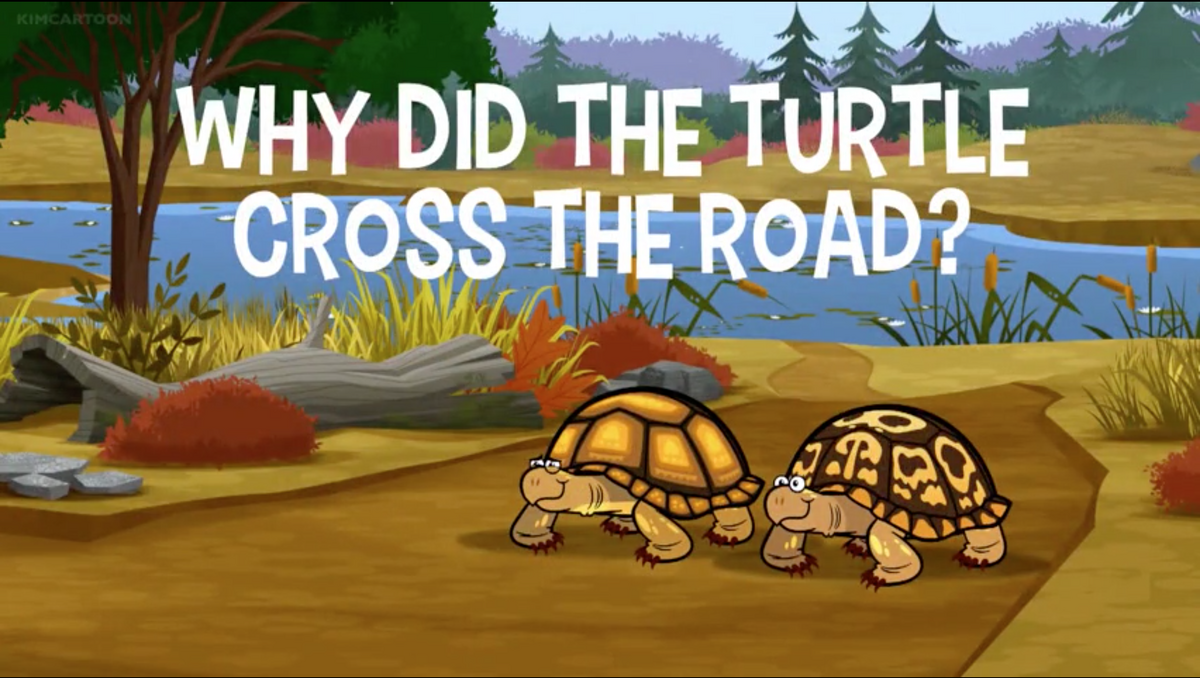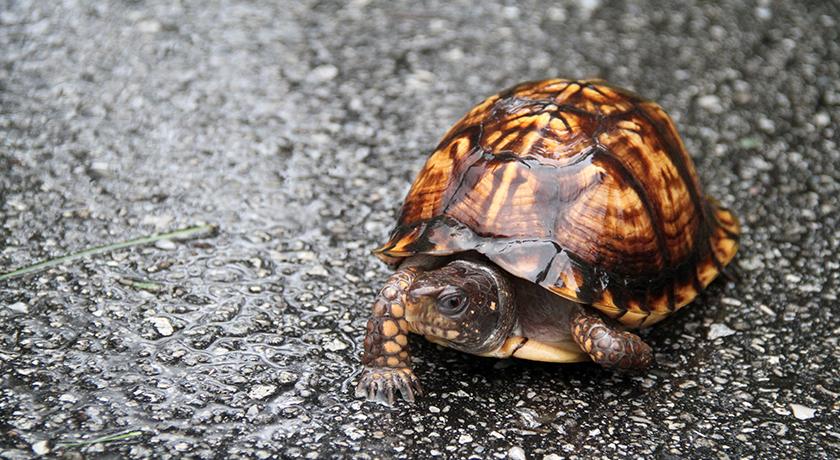The turtle crossed the road to reach its nesting site, seeking a safe place to lay eggs. Witnessing this natural behavior can be a rare and fascinating experience.
Turtles, known for their slow pace, face numerous dangers when venturing across roads. Understanding their migration patterns and behaviors is crucial for their conservation. As humans encroach on their habitats, road mortality poses a significant threat to turtle populations. By being mindful of these creatures and taking steps to protect them, we can help ensure the survival of these ancient reptiles for generations to come.
Next time you see a turtle crossing the road, remember the importance of preserving their habitats and ensuring their safe passage.
The Importance Of Turtle Crossings
Turtles crossing roads can be a matter of life and death. Without proper protections, these slow-moving creatures face significant risks when navigating through human-dominated landscapes.
Protecting Turtle Populations
Creating designated turtle crossings is crucial to ensure the safety of these vulnerable creatures. By establishing safe passage points, we can help reduce the number of turtle fatalities due to road incidents.
Impact Of Road Crossings On Turtle Species
Turtle populations are declining due to road crossings disrupting their natural habitats and migration patterns. Increased road traffic poses a significant threat to the survival of various turtle species.

Credit: nature-cat.fandom.com
Understanding Turtle Behavior
Turtles crossing roads is a common sight, but it’s crucial to understand the reasons behind it. This behavior is often linked to migration, nesting, or seeking food. By comprehending turtle behavior, we can take steps to protect them and reduce the risks they face when crossing roads.
Turtles are fascinating creatures, known for their longevity and slow pace. They are also known for their tendency to cross roads, which can be dangerous for them and for drivers. Understanding turtle behavior is crucial to prevent accidents and protect these animals. In this section, we will explore two important aspects of turtle behavior: migration patterns and factors influencing road crossings.Migration Patterns
Turtles are known for their long-distance migrations, which can take them from their nesting sites to feeding areas and back. Some species, like the sea turtle, travel thousands of miles every year. These migrations are often seasonal and can be influenced by factors such as temperature, daylight, and food availability.Factors Influencing Road Crossings
Turtles may cross roads for a variety of reasons, including searching for food, water, or nesting sites. However, many road crossings are unintentional and occur because turtles are simply trying to get to the other side. Factors that influence road crossings include:- Population density: Areas with high turtle populations are more likely to have road crossings.
- Distance to habitat: Turtles may cross roads to reach nearby habitats, such as wetlands or nesting sites.
- Time of day: Turtles are more likely to cross roads during the early morning or late afternoon.
- Weather conditions: Turtles may be more active during rainy or cloudy weather.
- Road design: Roads with steep embankments or barriers may prevent turtles from crossing safely.
In Conclusion
Understanding turtle behavior is key to preventing accidents and protecting these amazing creatures. By learning about migration patterns and factors influencing road crossings, we can take steps to ensure the safety of turtles and humans alike.Challenges Faced By Turtles On Roads
Traffic Hazards
Turtles face significant traffic hazards when crossing roads, as their slow movement makes them vulnerable to being hit by vehicles. The lack of speed combined with the inability to change direction quickly puts them at high risk of being run over, leading to injury or death.
Habitat Fragmentation
The construction of roads can lead to habitat fragmentation for turtles, disrupting their natural movements and access to suitable nesting sites and food sources. This fragmentation can have long-term impacts on turtle populations, affecting their ability to thrive in their natural habitats.

Credit: www.facebook.com
Human Intervention For Turtle Safety
Building Wildlife Crossings
Turtles are known to cross roads in search of suitable nesting sites or habitats. To help protect these slow-moving creatures, wildlife crossings are being built in areas where turtles are frequently observed crossing roads. These wildlife crossings provide a safe passage for turtles and other wildlife, reducing the risk of them being struck by vehicles.
Community Involvement
Communities play a crucial role in ensuring the safety of turtles and other wildlife. By raising awareness about the importance of protecting turtles and their habitats, communities can actively contribute to the conservation efforts. Additionally, community members can volunteer to monitor and assist turtles crossing roads, helping them reach their destination safely.
Legal And Conservation Efforts
When it comes to the safety and conservation of turtles, legal and conservation efforts play a vital role in protecting these creatures. Various legislation and conservation initiatives have been implemented to safeguard turtle populations and their habitats.
Legislation For Turtle Protection
Legislation for the protection of turtles involves the enactment of laws and regulations aimed at preserving their natural habitats and reducing human-induced threats. These laws often focus on prohibiting the hunting, trading, and disturbance of turtles and their nests, as well as the preservation of their critical nesting and feeding grounds.
Conservation Initiatives
Conservation initiatives are crucial for ensuring the long-term survival of turtles. Such efforts include the establishment of protected areas and wildlife reserves, habitat restoration projects, public awareness campaigns, and research programs to monitor turtle populations and behavior. Conservation organizations and government agencies collaborate to implement these initiatives, aiming to minimize human impacts on turtle populations and their habitats.

Credit: www.mass.gov
Case Studies Of Successful Interventions
Turtle Crossing Initiatives In Specific Regions
Efforts to protect turtles from road-related threats have been implemented in various regions, with notable successes observed in specific locations. These initiatives aim to mitigate the impact of road mortality on turtle populations and ensure their safe passage across roadways.
Measuring Impact Of Conservation Efforts
Quantifying the effectiveness of conservation efforts is crucial in assessing the success of interventions aimed at safeguarding turtle populations. Through rigorous monitoring and data analysis, the impact of conservation measures can be accurately evaluated, providing valuable insights for future conservation strategies.
Educational Outreach And Awareness
Wildlife crossings are essential for the safety of both animals and humans. Turtles, for instance, often cross the road to get to their nesting sites or to find food. Unfortunately, many of them become victims of road accidents. Educational outreach and awareness programs can help reduce the number of turtle fatalities on roads and promote safe driving practices.
Promoting Safe Driving Practices
When driving on roads that cross through wildlife habitats, drivers must be cautious and keep an eye out for animals. Promoting safe driving practices can help mitigate the risks of collisions with turtles and other wildlife. Here are some tips:
- Slow down when approaching areas where turtles are likely to cross the road.
- Be alert and watch for movement on or near the road.
- Use your headlights to increase your visibility, especially during dusk and dawn when turtles are most active.
Educating The Public About Turtle Crossings
Many people are not aware of the risks that turtles face when crossing roads. Educational outreach and awareness programs can help inform the public about the importance of wildlife crossings and the need to protect turtles and other animals. Here are some key points that can be highlighted in these programs:
| Key Points | Explanation |
|---|---|
| Turtles are slow-moving creatures | They often take a long time to cross roads, making them vulnerable to vehicles. |
| Turtles play an important role in the ecosystem | They help maintain the balance of aquatic ecosystems by controlling the populations of other animals and plants. |
| Turtle populations are declining | Many turtle species are threatened or endangered due to habitat loss, pollution, and other factors. |
By educating the public about the importance of turtle crossings and promoting safe driving practices, we can help protect these fascinating creatures and ensure their survival for generations to come.
Future Prospects For Turtle Conservation
Wildlife corridors are crucial for turtle populations to safely cross roads.
- Land bridges
- Underpasses
- Fencing along roads
Advanced technology aids in monitoring turtle movements for conservation efforts.
- GPS trackers
- Radio telemetry
- Satellite tracking
Conclusion
Next time you see a turtle crossing the road, remember, they’re just seeking a safe place. By understanding their journey, we can help protect these gentle creatures. Let’s all do our part to ensure their safety and preserve their habitats.
Together, we can make a difference.






Leave a Reply